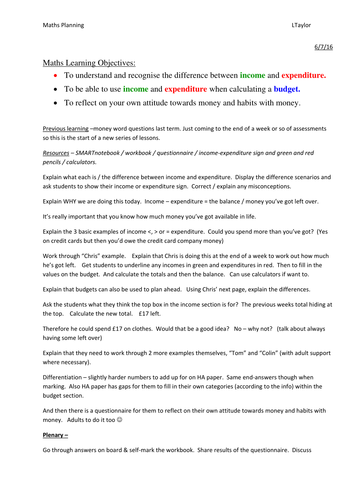







These resources are those that I made for a KS3-KS4 class of boys with Autism to begin a section of work on budgeting and finance. (I was lucky enough too to have this lesson graded as outstanding) It would also be appropriate for a high KS1- lower KS2 class, though you may want to alter the income in the 3rd example - as it's currently about a young man with autism who receives a Personal Independence Payment of £800. Then again, you may not, as it would be a talking point!
It has a great SMART notebook interactive presentation which you use to teach them the difference between income and expenditure. There is a simple flip sign that when folded they can each display to you after they've decided if the given scenarios are income or expenditure. It then works through a example about a boy called Chris who has a variety of income and expenditures. The students, in their workbooks, use a green and red pencil to highlight the values with you demonstrating on the board if necessary. They then use the values to calculate the balances. The SMART notebook then demonstrates the use of budgets to plan for upcoming weeks as well as working out a week that has just passed.
The workbooks, print them out in booklet form on A3 colour, to make 'grown up' lecture note books. The students then have 2 more examples to work through, with various life-skills questions relating to the balance - for example how many weeks would it take Tom to save up to buy a the FIFA game?
Values / names could be easily changed if you wanted to make the task easier / harder.
I've also included the excel spread sheet if you want to create new types of income / expenditure than the ones given.
The 3rd objective, involving assessing their attitude to money, gives them 10 questions and asks what they would do for each question via 3 different options. eg. if you found £10 on the floor would you: a) hand it to someone in authority b) spend it yourself etc. Just a bit of fun to end the lesson with discussion and refection on money attitudes. My staff did it too. Print this out on booklet A3, then the questions will all be on the inside 2 pages for easy completion and scoring (another useful maths skill in some ways).
There's also a completed work book which I displayed on board for the students to mark their work at the end of the lesson.
Lastly, the lesson plan I used is included too.
It has a great SMART notebook interactive presentation which you use to teach them the difference between income and expenditure. There is a simple flip sign that when folded they can each display to you after they've decided if the given scenarios are income or expenditure. It then works through a example about a boy called Chris who has a variety of income and expenditures. The students, in their workbooks, use a green and red pencil to highlight the values with you demonstrating on the board if necessary. They then use the values to calculate the balances. The SMART notebook then demonstrates the use of budgets to plan for upcoming weeks as well as working out a week that has just passed.
The workbooks, print them out in booklet form on A3 colour, to make 'grown up' lecture note books. The students then have 2 more examples to work through, with various life-skills questions relating to the balance - for example how many weeks would it take Tom to save up to buy a the FIFA game?
Values / names could be easily changed if you wanted to make the task easier / harder.
I've also included the excel spread sheet if you want to create new types of income / expenditure than the ones given.
The 3rd objective, involving assessing their attitude to money, gives them 10 questions and asks what they would do for each question via 3 different options. eg. if you found £10 on the floor would you: a) hand it to someone in authority b) spend it yourself etc. Just a bit of fun to end the lesson with discussion and refection on money attitudes. My staff did it too. Print this out on booklet A3, then the questions will all be on the inside 2 pages for easy completion and scoring (another useful maths skill in some ways).
There's also a completed work book which I displayed on board for the students to mark their work at the end of the lesson.
Lastly, the lesson plan I used is included too.
Something went wrong, please try again later.
This resource hasn't been reviewed yet
To ensure quality for our reviews, only customers who have purchased this resource can review it
Report this resourceto let us know if it violates our terms and conditions.
Our customer service team will review your report and will be in touch.
£2.00
